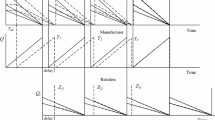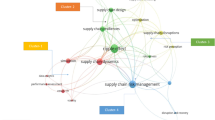Abstract
Natural or man-made disasters lead to disruptions across entire supply chain, hugely affecting the entire distribution system. Owing to disaster, the supply chain usually takes longer time to recover and eventually leads to loss in reputation and revenue. Therefore, business organizations are constantly focusing on making its distribution network of a supply chain resilient to either man-made or natural disasters in order to satisfy customer demand in time. The supply chain distribution network broadly comprises of two major decisions i.e. facility location and vehicle routing. The paper addresses these distribution decisions jointly as location-routing problem. The paper proposes Location-Routing Model with Time Windows using proactive and reactive approaches. In proactive approach, the risk factors are considered as preventive measure for disaster caused disruptions. The model is extended for reactive approach by considering the disruptions such as facility breakdowns, route blockages, and delivery delays with cost penalties. The case illustration is discussed for proactive approach. In case of disaster caused disruptions, the reactive approach is illustrated using three disruption case scenarios. Using both proactive and reactive approach, designing the distribution system can make the overall supply chain a disaster resilient supply chain.

Similar content being viewed by others
References
Ahmadi-Javid, A., & Seddighi, A. H. (2012). A location-routing-inventory model for designing multisource distribution networks. Engineering Optimization, 44(6), 637–656.
Anaya-Arenas, A. M., Renaud, J., & Ruiz, A. (2014). Relief distribution networks: A systematic review. Annals of Operations Research, 223(1), 53–79.
Berman, O., Krass, D., & Menezes, M. B. (2009). Locating facilities in the presence of disruptions and incomplete information. Decision Sciences, 40(4), 845–868.
Bhattacharya, A., Geraghty, J., Young, P., & Byrne, P. J. (2013). Design of a resilient shock absorber for disrupted supply chain networks: A shock-dampening fortification framework for mitigating excursion events. Production Planning and Control, 24(8–9), 721–742.
Burkart, C., Nolz, P. C., & Gutjahr, W. J. (2016). Modelling beneficiaries’ choice in disaster relief logistics. Annals of Operations Research, 1–21.
Chen, J., Sohal, A. S., & Prajogo, D. I. (2013). Supply chain operational risk mitigation: A collaborative approach. International Journal of Production Research, 51(7), 2186–2199.
Christopher, M., & Peck, H. (2004). Building the resilient supply chain. The international journal of logistics management, 15(2), 1–14.
Coles, J. B., Zhang, J., & Zhuang, J. (2017). Bridging the research-practice gap in disaster relief: Using the IFRC code of conduct to develop an aid model. Annals of Operations Research, 1–21.
Craig, R. A., Angeler, D. G., Cumming, G. S., Folke, C., Twidwell, D., & Uden, D. R. (2016). Quantifying spatial resilience. Journal of Applied Ecology, 53(3), 625–635.
Dong, J., Zhang, D., Yan, H., & Nagurney, A. (2005). Multitiered supply chain networks: Multicriteria decision—making under uncertainty. Annals of Operations Research, 135(1), 155–178.
DuHadway, S., Carnovale, S., & Hazen, B. (2017). Understanding risk management for intentional supply chain disruptions: Risk detection, risk mitigation, and risk recovery. Annals of Operations Research, 1–20.
Duhamel, C., Santos, A. C., Brasil, D., Châtelet, E., & Birregah, B. (2016). Connecting a population dynamic model with a multi-period location-allocation problem for post-disaster relief operations. Annals of Operations Research, 247(2), 693–713.
Ellis, S. C., Shockley, J., & Henry, R. M. (2011). Making sense of supply disruption risk research: A conceptual framework grounded in enactment theory. Journal of Supply Chain Management, 47(2), 65–96.
Fahimnia, B., & Jabbarzadeh, A. (2016). Marrying supply chain sustainability and resilience: A match made in heaven. Transportation Research Part E: Logistics and Transportation Review, 91, 306–324.
Falasca, M., Zobel, C. W., & Cook, D. (2008). A decision support framework to assess supply chain resilience. In Proceedings of the 5th International ISCRAM Conference (pp. 596–605).
Gong, J., Mitchell, J. E., Krishnamurthy, A., & Wallace, W. A. (2014). An interdependent layered network model for a resilient supply chain. Omega, 46, 104–116.
Hale, T., & Moberg, C. R. (2005). Improving supply chain disaster preparedness: A decision process for secure site location. International Journal of Physical Distribution and Logistics Management, 35(3), 195–207.
Hazen, B. T., Skipper, J. B., Boone, C. A., and Hill, R. R. (2016). Back in business: Operations research in support of big data analytics for operations and supply chain management. Annals of Operations Research, 1–11.
Huang, X., & Song, L. (2016). An emergency logistics distribution routing model for unexpected events. Annals of Operations Research, 1–17.
Huang, Z., Zheng, Q. P., Pasiliao, E. L., & Simmons, D. (2017). Exact algorithms on reliable routing problems under uncertain topology using aggregation techniques for exponentially many scenarios. Annals of Operations Research, 249(1–2), 141–162.
Javid, A. A., & Azad, N. (2010). Incorporating location, routing and inventory decisions in supply chain network design. Transportation Research Part E: Logistics and Transportation Review, 46(5), 582–597.
Javid, A. A., & Seddighi, A. H. (2013). A location-routing problem with disruption risk. Transportation Research Part E: Logistics and Transportation Review, 53, 63–82.
Jin, S., Jeong, S., Kim, J., & Kim, K. (2015). A logistics model for the transport of disaster victims with various injuries and survival probabilities. Annals of Operations Research, 230(1), 17–33.
Kaur, H., & Singh, S. P. (2016). Sustainable procurement and logistics for disaster resilient supply chain. Annals of Operations Research, 1–46.
Kristianto, Y., Gunasekaran, A., Helo, P., & Hao, Y. (2014). A model of resilient supply chain network design: A two-stage programming with fuzzy shortest path. Expert Systems with Applications, 41(1), 39–49.
Li, J. Q., Mirchandani, P. B., & Borenstein, D. (2009). Real-time vehicle rerouting problems with time windows. European Journal of Operational Research, 194(3), 711–727.
Li, X., & Ouyang, Y. (2010). A continuum approximation approach to reliable facility location design under correlated probabilistic disruptions. Transportation research part B: methodological, 44(4), 535–548.
Mandal, S. (2012). An empirical investigation into supply chain resilience. IUP Journal of Supply Chain Management, 9(4), 46.
Mari, S. I., Lee, Y. H., Memon, M. S., Park, Y. S., & Kim, M. (2015). Adaptivity of complex network topologies for designing resilient supply chain networks. International Journal of Industrial Engineering, 22(1), 102–116.
María Jesús Sáenz, E. R. (2014). MIT Sloan Management Review. Retrieved from sloanreview.mit.edu: http://sloanreview.mit.edu/article/creating-more-resilient-supply-chains/.
Mu, Q., Fu, Z., Lysgaard, J., & Eglese, R. (2011). Disruption management of the vehicle routing problem with vehicle breakdown. Journal of the Operational Research Society, 62(4), 742–749.
Perl, J., & Daskin, M. S. (1985). A warehouse location-routing problem. Transportation Research Part B: Methodological, 19(5), 381–396.
Ponomarov, S. Y., & Holcomb, M. C. (2009). Understanding the concept of supply chain resilience. The International Journal of Logistics Management, 20(1), 124–143.
Qi, L., Shen, Z. J. M., & Snyder, L. V. (2010). The effect of supply disruptions on supply chain design decisions. Transportation Science, 44(2), 274–289.
Ratick, S., Meacham, B., & Aoyama, Y. (2008). Locating backup facilities to enhance supply chain disaster resilience. Growth and Change, 39(4), 642–666.
Rice, J. B., & Caniato, F. (2003). Building a secure and resilient supply network. Supply Chain Management Review, 7(5), 22–30.
Sáenz, M. J., & Revilla, E. (2014). Creating more resilient supply chains. MIT Sloan Management Review, 55(4), 22.
Sawik, T. (2013). Selection of resilient supply portfolio under disruption risks. Omega, 41(2), 259–269.
Shen, Z. J. M., Zhan, R. L., & Zhang, J. (2011). The reliable facility location problem: Formulations, heuristics, and approximation algorithms. INFORMS Journal on Computing, 23(3), 470–482.
Snyder, L. V., & Daskin, M. S. (2005). Reliability models for facility location: The expected failure cost case. Transportation Science, 39(3), 400–416.
Sodhi, M. S., Son, B. G., & Tang, C. S. (2012). Researchers’ perspectives on supply chain risk management. Production and Operations Management, 21(1), 1–13.
Tang, C. S. (2006). Robust strategies for mitigating supply chain disruptions. International Journal of Logistics: Research and Applications, 9(1), 33–45.
Tayal, A., & Singh, S. P. (2017). Formulating multi-objective stochastic dynamic facility layout problem for disaster relief. Annals of Operations Research, 1–27.
Wang, X., Wu, X., & Hu, X. (2010). A study of urgency vehicle routing disruption management problem. 2010 WASE International Conference on Information Engineering (ICIE), (Vol. 3, pp. 452–455). IEEE.
Wang, X., Wu, Y., Liang, L., & Huang, Z. (2016). Service outsourcing and disaster response methods in a relief supply chain. Annals of Operations Research, 240(2), 471–487.
Wieland, A., & Marcus Wallenburg, C. (2013). The influence of relational competencies on supply chain resilience: A relational view. International Journal of Physical Distribution and Logistics Management, 43(4), 300–320.
Wilson, M. C. (2007). The impact of transportation disruptions on supply chain performance. Transportation Research Part E: Logistics and Transportation Review, 43(4), 295–320.
World Economic Forum. (2013). Building resilience in supply chain: An initiative of the risk response network in collaboration with accenture.
Author information
Authors and Affiliations
Corresponding author
Additional information
Publisher's Note
Springer Nature remains neutral with regard to jurisdictional claims in published maps and institutional affiliations.
Appendix:
Appendix:
1.1 Lingo Code for LRMTW considering risk factor



1.2 Lingo Code LRMTW under disaster caused disruptions



Rights and permissions
About this article
Cite this article
Elluru, S., Gupta, H., Kaur, H. et al. Proactive and reactive models for disaster resilient supply chain. Ann Oper Res 283, 199–224 (2019). https://doi.org/10.1007/s10479-017-2681-2
Published:
Issue Date:
DOI: https://doi.org/10.1007/s10479-017-2681-2




